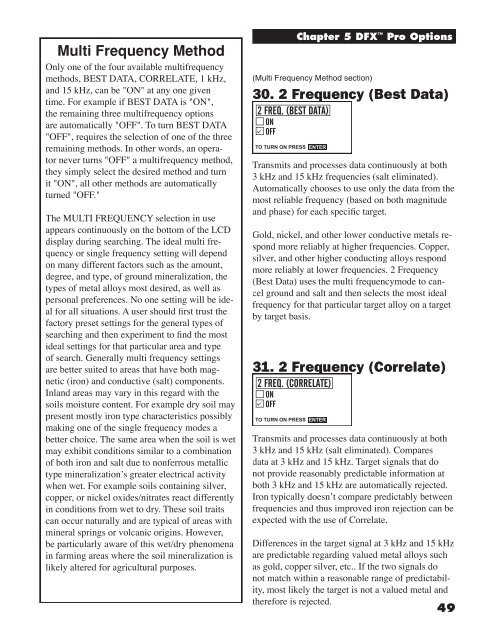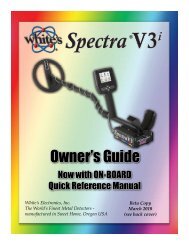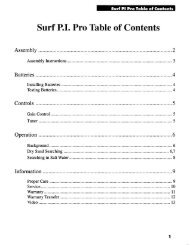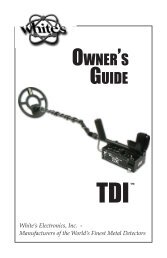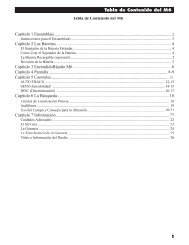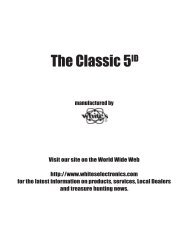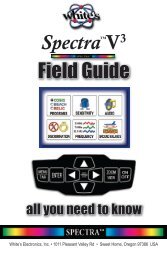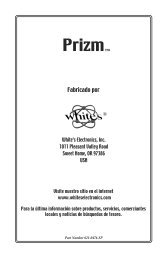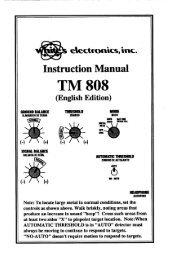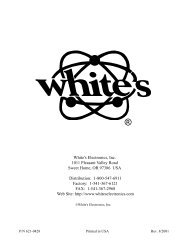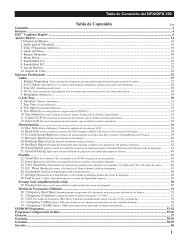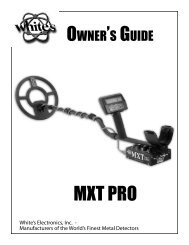DFX 300 Manual - White's Metal Detectors
DFX 300 Manual - White's Metal Detectors
DFX 300 Manual - White's Metal Detectors
Create successful ePaper yourself
Turn your PDF publications into a flip-book with our unique Google optimized e-Paper software.
Multi Frequency Method<br />
Only one of the four available multifrequency<br />
methods, BEST DATA, CORRELATE, 1 kHz,<br />
and 15 kHz, can be "ON" at any one given<br />
time. For example if BEST DATA is "ON",<br />
the remaining three multifrequency options<br />
are automatically "OFF". To turn BEST DATA<br />
"OFF", requires the selection of one of the three<br />
remaining methods. In other words, an operator<br />
never turns "OFF" a multifrequency method,<br />
they simply select the desired method and turn<br />
it "ON", all other methods are automatically<br />
turned "OFF."<br />
The MULTI FREQUENCY selection in use<br />
appears continuously on the bottom of the LCD<br />
display during searching. The ideal multi frequency<br />
or single frequency setting will depend<br />
on many different factors such as the amount,<br />
degree, and type, of ground mineralization, the<br />
types of metal alloys most desired, as well as<br />
personal preferences. No one setting will be ideal<br />
for all situations. A user should fi rst trust the<br />
factory preset settings for the general types of<br />
searching and then experiment to fi nd the most<br />
ideal settings for that particular area and type<br />
of search. Generally multi frequency settings<br />
are better suited to areas that have both magnetic<br />
(iron) and conductive (salt) components.<br />
Inland areas may vary in this regard with the<br />
soils moisture content. For example dry soil may<br />
present mostly iron type characteristics possibly<br />
making one of the single frequency modes a<br />
better choice. The same area when the soil is wet<br />
may exhibit conditions similar to a combination<br />
of both iron and salt due to nonferrous metallic<br />
type mineralizationʼs greater electrical activity<br />
when wet. For example soils containing silver,<br />
copper, or nickel oxides/nitrates react differently<br />
in conditions from wet to dry. These soil traits<br />
can occur naturally and are typical of areas with<br />
mineral springs or volcanic origins. However,<br />
be particularly aware of this wet/dry phenomena<br />
in farming areas where the soil mineralization is<br />
likely altered for agricultural purposes.<br />
Chapter 5 <strong>DFX</strong> Pro Options<br />
(Multi Frequency Method section)<br />
30. 2 Frequency (Best Data)<br />
Transmits and processes data continuously at both<br />
3 kHz and 15 kHz frequencies (salt eliminated).<br />
Automatically chooses to use only the data from the<br />
most reliable frequency (based on both magnitude<br />
and phase) for each specifi c target.<br />
Gold, nickel, and other lower conductive metals respond<br />
more reliably at higher frequencies. Copper,<br />
silver, and other higher conducting alloys respond<br />
more reliably at lower frequencies. 2 Frequency<br />
(Best Data) uses the multi frequencymode to cancel<br />
ground and salt and then selects the most ideal<br />
frequency for that particular target alloy on a target<br />
by target basis.<br />
31. 2 Frequency (Correlate)<br />
Transmits and processes data continuously at both<br />
3 kHz and 15 kHz (salt eliminated). Compares<br />
data at 3 kHz and 15 kHz. Target signals that do<br />
not provide reasonably predictable information at<br />
both 3 kHz and 15 kHz are automatically rejected.<br />
Iron typically doesnʼt compare predictably between<br />
frequencies and thus improved iron rejection can be<br />
expected with the use of Correlate.<br />
Differences in the target signal at 3 kHz and 15 kHz<br />
are predictable regarding valued metal alloys such<br />
as gold, copper silver, etc.. If the two signals do<br />
not match within a reasonable range of predictability,<br />
most likely the target is not a valued metal and<br />
therefore is rejected.<br />
49


